Please see legal disclaimer and copyright information below
This Gazette was written exclusively for a client
Shipping Gazette
Latest maritime and legal news from Panama and around the world
| Panama, September 2010 | Volume 2, Number 04 |
Welcome Welcome to the latest edition of Shipping Gazette, we do hope you find it helpful and interesting. Your feedback is always appreciated and you can contact our maritime legal team by email
Panama at Posidonia
Posidonia – Where everything happens! With this phrase, Steven Zhang, Deputy Manager, Repair & Conversion Department of China’s Cosco Shipyard Group described what everyone feels visiting Posidonia.
In our last issue we promised a special report about the Panama Pavilion at Posidonia and the visit of our Panamanian Delegation.
The President of Panama, Mr. Ricardo Martinelli visited Posidonia 2010, the biggest international sea transportation event; Mr. Martinelli was welcomed by officials of exhibition and had the opportunity to visit stands of many international shipping companies representing a variety of activities within the industry, from ship building, maritime services and equipment manufacturing.
While in Athens, President Ricardo Martinelli and the Panamanian Delegation visited shipowners and industry leaders. After his visit to the exhibits, the President said: “Posidonia is an exceptional maritime event which is extremely well organized and highly beneficial to all marine industry stakeholders worldwide. Panama, like Greece, share significant shipping heritage and we are always delighted to participate in Posidonia, a forum that helps us promote the strengths of our flag.”
As part of the Panamanian delegation, accompanying the president, was the Minister of the Presidency, Mr. Jimmy Papadimitrius, a Panamanian born of Greek roots and fluent in Greek, the administrator of the Maritime Authority, Mr. Roberto Linares, and Mr. Alfonso Castillero, the Director General of Merchant Marine.
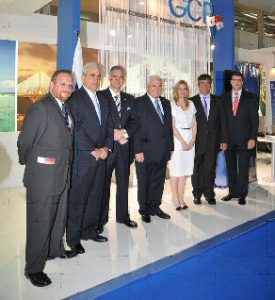 |
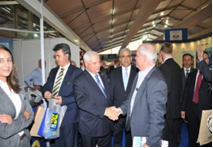 President Martinelli touring Posidonia
President Martinelli touring Posidonia
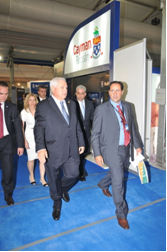 |
| (Left to Right) Lic. Adolfo Linares, Roberto Linares, Administrator of the Panama Maritime Authority, Lic. Julio de la Lastra, President of the Panama Maritime Chamber, H.E. Ricardo Martinelli, President of Panama, Ms. Felicia Dushka Papadimitriou, Ambassadress of Panama in Greece, Mr. Jimmy Papadimitrious, Minister of the Presidency, Lic. Alex Orillac, Vice-President of the Panama Maritime Chamber. |
The delegation toured the 31,000 square metre floor space of the Hellenikon Exhibition for more than an hour. In the evening the Panama Registry offered a reception for clients, users and friends.
The Ambassadress of Panama in Greece, Ms. F. Papadimitrious and her team organised the Panama stand and the reception, playing an exceptional role as hosts to all the thousands of visitors and users of our Registry touring the exhibition. Greek owners control 22,4 % of the world oil tanker fleet and 24,6% of the world bulk carrier fleet, and Panama has been a favourite registry for their ships.
“I am not a politician,” said the President addressing his 400 guests at a pool-side reception of the Divani Apollon Hotel. “I am a businessman who is here in Greece to meet with the world of shipping and identify business opportunities for my country”.
The global appeal of Posidonia 2010 was reflected by the impressive numbers and important stakeholders who were among the event’s 18,000 visitors from 87 nations who attended the prestigious forum. A record 1,859 exhibitors participated in Posidonia 2010 across an area of 31,000 square metres which also saw a record 21 national pavilions.
Next Posidonia will be in June 2012, however, organisers said that spaces are already being reserved and it is most likely the exhibition area will increase yet again due to high demand.
Source: http://www.posidonia-events.com/online/
Panama Marine Circulars – Know what is required of you – This month MM Circulars numbers 169, 209, 212 and 213.
| Merchant Marine Circular (MMC) | |||||||
|
|
||||||
| http://segumar.com/HTML Merchant Marine Circulars/169.pdf | |||||||
|
|
||||||
| http://segumar.com/HTML Merchant Marine Circulars/209.pdf | |||||||
|
|
||||||
| http://segumar.com/HTML Merchant Marine Circulars/212.pdf | |||||||
|
|
||||||
| http://segumar.com/HTML Merchant Marine Circulars/176.pdf | |||||||
Are you complying with the Annual Safety Inspection (ASI) Scheme for the Panamanian registered vessels?
The Annual Safety Inspection Programme for Panamanian flag vessels was established through Law No. 39 dated July 8th 1976.
The law specifically requests that every vessel shall undergo an Annual Safety Inspection (ASI) in order to determine if it fulfills the International and National Safety Regulation requirements.
The Panamanian Maritime Authority has a database and constantly is summoning vessels that have not complied with the mandatory Annual Safety Inspection according to Law No. 39.
The Authority has technical personnel ready to coordinate and make all the arrangements required to ensure compliance at a convenient time and place for your vessel, without any interruption on your routine work or sailing schedule.
Please email us for further information or to arrange for an ASI for your vessel(s).
Source: www.segumar.com – circulars – #20, #171 and #201Latest review from the Paris MoU
As from 1 January 2010 the PARIS MOU is planning a new Inspection Regime. Ships will be divided into High, Standard and Low Risk. For the first time company performance will contribute to the risk profile. Banning measures will be extended to all ship types and apply to flags on the “Black List” and “Grey List”.
Since 17 June 2009 detentions are being counted and some ships will no longer be welcome in Paris MoU ports after 2011 and will be “banned” for a minimum period. While low-risk ships will be rewarded with a 24 to 36 month inspection interval, high-risk ships will be subject to a more rigorous inspection regime with an expanded inspection every 6 months.
With 8,501 inspections and 1,250 detentions the ships flying a “black listed flag“ score a detention rate of 14.7 %. For ships flying a “grey listed flag” the detention rate is 7.1% (11,223 inspections, 798 detentions) and ships flying a “white listed flag” 2.8% (51,548 inspections and 1,428 detentions).
The 27 members of the agreement have carried out 24,186 inspections in 2009. The number of detentions has dropped slightly from 1,220 in 2008 to 1,059 in 2009. Over the period 2007-2009 ships flying a “black listed flag” have the highest detention rate.
With 8,501 inspections and 1,250 detentions they score a detention rate of 14.70 %. For ships flying a “grey listed flag” the detention rate is 7.21% (11,223 inspections, 809 detentions) and ships flying a “white listed flag” 2.98% (47,885 inspections and 1,427 detentions).
In 2009 a total of 13 ships were banned. Five were flying a “black listed flag”, 4 were flying a “white listed flag” and 4 were flying a “grey listed flag” at the time of the banning.
General dry cargo ships have the highest detention rate (6.8%), followed by refrigerated cargo ships (5.1%) and bulk carriers (4.6%)
From September to December 2009 a concentrated inspection campaign (CIC) on lifeboat launching arrangements was carried out. A matter of serious concern is that 1 out of every 5 inspections showed deficiencies in this area. In total 2,136 CIC related deficiencies were recorded during the inspections.
During the 3-month period 246 ships were detained. In 80 cases (32%) the lifeboat launching appliances had deficiencies that were serious enough to detain the ship.
The campaign also revealed that one out of eight drills, when conducted, was not performed satisfactorily.
Due to a better performance, Panama has now been removed from the black list.
The Panama Maritime Authority aiming to maintain a high quality standard of ships in its Registry issued Resolution N. 106-26-DGMM on July 02, 2008 warning shipowners that vessel with more than two subsequent detentions or that not complies with the required Occasional Survey will be removed from the registry.
If your vessel is detained please email us immediately our specialised team can liaise with the Panama Maritime Authority ensuring the minimal interruption possible in cases of unfair/unlawful detention.
The full report is available on the Paris MoU web site: www.parismou.org
Source: http://www.parismou.org/upload/anrep/ANREP2009 press release FINAL1.pdf
What’s new in Panama shipping scene? Maritime Authority of Panama completes the Annual external audit review conducted by Lloyd”s Register Quality Assurance Inc. (LRQA)
|
The external audit aimed to verify all the processes of the ISO 9001:2000. The certification was awarded to the AMP a couple of years ago. The scope of the audit, which was passed without any no-conformities, involved the areas of planning, customer service, follow up and improvement, ship registry, navigation and maritime security, inspections, human resources, competence and training, purchasing, providers and documentation control and the revision of management indicators. Source: http://www.laestrella.com.pa/mensual/2010/05/29/contenido/239451.asp |
 |
| Closing meeting of LRQA’s auditor with the AMP Administrator |
A spectacular welcome greeted the crews of the Clipper 09-10 Round the World Yacht Race as they arrived back in Hull (England) at the end of their 35,000-mile circumnavigation. For the non-professional crew onboard the ten ocean racing yachts, the return to Hull Marina marked the end of a challenge of a lifetime as they battled the elements in search of victory and the title of Clipper 09-10 Round the World Yacht Race champions.
Setting off from the Humber in the north east of England on 13 September 2009, the route took the fleet of ten identical 68-foot racing yachts on a ten-month odyssey around the globe.
From Europe across the Atlantic Ocean to South America, on to Africa, Australia, Singapore, China, across the Pacific Ocean, through the Panama Canal, one of man’s great engineering triumphs, through the Caribbean to the east coast of the North American continent and back across the Atlantic Ocean to Europe.
During their visit in Panama, they stayed at the Flamenco Marina, before sailing through the Panama Canal on their way to Jamaica. Congratulations to the winner!
Source: “La Estrella de Panama” http://www.laestrella.com.pa/mensual/2010/05/16/contenido/235269.asp and the official website http://www.clipperroundtheworld.com/index.php/Home
Project to watch dolphins in “Las Perlas” Archipelago in Panama’s Pacific coast.
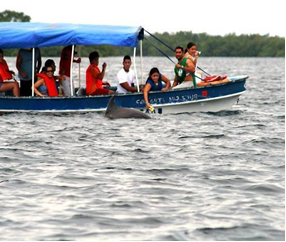 A new Project was recently implemented in Panama to watch dolphins in the waters of Las Perlas Archipelago. The initiatives to offer to the local rural communities the opportunity to generate income thus improve their quality of life.
A new Project was recently implemented in Panama to watch dolphins in the waters of Las Perlas Archipelago. The initiatives to offer to the local rural communities the opportunity to generate income thus improve their quality of life.
This project is under the Maritime University (UMIP) and backed by the Argentinean Foundation Cethus and the Alliance for the conservation and development (ACD) to bring forward the project and to minimise the impact on the species and the marine ecosystems.
The three month project organised a workshop in the Community Home of San Miguel Island aiming to train the local fishermen and tourism operators in the watch and treatment of the dolphins. The International organisation of conservation is funding the project.
Source: http://www.laestrella.com.pa/mensual/2010/05/12/contenido/232986.asp
Port News: Panama’s Global Programme of Containers Control
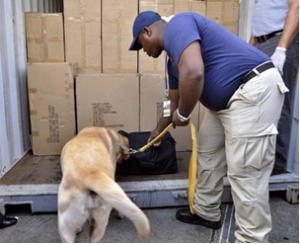 The National Customs Authority has presented the Global Programme of Containers Control with the purpose to analyse the cargo in the containers passing through the Panamanian ports.
The National Customs Authority has presented the Global Programme of Containers Control with the purpose to analyse the cargo in the containers passing through the Panamanian ports.
The Directors of Customs in Panama, Dr. Gloria Moreno de Lopez informed that the programme aims to prevent the use of Panamanian ports for transhipments of illegal goods. An agreement of cooperation is currently in force signed by the Customs and the UN to fight against the traffic of drugs.
Between January and May 2010 there were 1,181 inspections, a record figure worldwide. During the same period in 2009 there were only 356 inspections.
During those inspections, counterfeit branded goods, drugs and illegal contraband of cigarettes were detected.
The UN has assisted the Panamanian institution with the provision of sophisticated equipment to detect illegal goods. The programme has also trained officials from the National Police, Security Council, the Maritime Authority and the Panama Canal.
Source: http://www.laestrella.com.paPanama Canal Update
Panama Canal Celebrates 96 Years of Service to Global Trade
Sunday, August 15, the Panama Canal celebrated 96 years of service to global trade. The United States took over the construction of the Panama Canal on May 4, 1904 and 10 years later, on August 15, 1914 the SS Ancon, officially inaugurated the waterway on its first transit August 15, 1914.
During that first crossing, and onboard the SS Ancon, there were distinguished guests, US and Panama governments officials and members of the diplomatic corps accredited in Panama.
Contrary to what people usually think, the first transit sailed from Colon in the Atlantic coast to Panama City in the Pacific coast. The guests were transported from Panama City by rail at dawn to bring them back to Panama on board the SS Ancon, which was a small cement cargo ship used during the construction of the Panama Canal.
For the special commemoration of the first transit there were 50,000 limited edition coins minted for the occasion that were given to the guests on board as a memento of this historical crossing.
The cost of construction was US$375,201,000, the finished canal spans 40.27 miles from shore to shore. There was a total of 211 million cubic yards of earth excavated for the construction. The canal is built 85 feet above sea level, locks are used to raise and lower ships.
Today, the Canal continues as a viable global transportation and logistics leader, connecting more than 144 different trade routes and uniting the world.
As the historic $5.25 billion Expansion Program continues as planned, the Panama Canal Authority looks optimistically forward to the future and remains committed to providing top-notch service for years to come.
Source: www.pancanal.com
Panama Canal Receives Bids for Pacific Access Channel Entrance Expansion Project
Project represents last major expansion contract to be awarded
The Panama Canal Authority (ACP) received three bids from international firms vying to dredge and excavate the Pacific Access Channel (PAC) entrance. This project represents the last major Expansion Program contract to be awarded and once completed, will allow larger ships to successfully enter the new access channel and reach the new Pacific Locks. Of note, the access channel will link the new Pacific locks with the Gaillard Cut (the narrowest stretch of the Panama Canal).
The ACP will award the contract to the firm with the lowest-priced bid that meets all of the terms and conditions in the request for proposals. The contractor then has a 90-day procurement and mobilization period before receiving the notice to proceed.
Below are the companies that submitted bids and the corresponding bid prices.
| Company | Amount USD | ||||||
|
|
||||||
|
|
||||||
|
|
The scope of work for the contract will include an estimated 4 million cubic metres of dredging and excavation at the PAC entrance.
Moreover, the ACP will ensure all of the work meets specific environmental requirements.
Expansion will build a new lane of traffic along the Panama Canal through the construction of a new set of locks, which will double capacity and allow more traffic and longer, wider ships.
Source: www.pancanal.com Annual Schedule Locks Maintenance WorkAdvisory to shipping number A-14-2010 – the normal transit capacity of the Panama Canal is 38-40 vessels each day, depending on vessel mix and other factors. This capacity is reduced during locks maintenance work, as indicated below. Consequently, vessels may experience delays in transiting.
| ANNUAL SCHEDULE LOCKS MAINTENANCE WORK | |||||||||||||||||||||||||||
|
|
|
|
|
|
|
|||||||||||||||||||||
|
|
|
|
|
|
|
|||||||||||||||||||||
|
|
|
|
|
|
|
|||||||||||||||||||||
Normally, during these periods, the Panama Canal Transit Reservation System slots are fully utilized. Whenever a set of locks requires a major outage of one of its two lanes for dry chamber inspection, mitre gate repairs, tow track work or other major maintenance/improvement projects, advantage may be taken of this requirement to perform simultaneous single lane outages for additional maintenance at other locks.
Starting September 6, 2010, and for approximately six weeks, a portion of the Gaillard Cut will be closed for shipping between 2200 hours and 0600 hours Monday to Friday, due to dredging operations in Cucaracha and Paraiso reaches. As a result, the estimated transit capacity will be 30-32 vessels, depending on vessel mix and transit restrictions
Source: www.pancanal.com
Panama Canal Authority signs first-ever partnership agreement with the Mississippi State Port Authority at Gulfport
The strategic alliance aims to increase economic growth, spur international trade and promote the “all water route”
Panama Canal Authority (ACP) Administrator/CEO Alberto Alemán Zubieta and Mississippi State Port Authority at Gulfport (MSPA) Executive Director/CEO Donald R. Allee launched a strategic partnership in Panama by signing a Memorandum of Understanding (MOU) to increase economic growth, spur international trade and promote the “All-Water Route” (the route from Asia to the U.S. East and Gulf Coasts via the Panama Canal).
The MSPA is an Enterprise Agency of the State of Mississippi and is responsible for the daily operations of the Port of Gulfport. MSPA’s mission is to be a profitable, self-sufficient port providing world class maritime terminal service to present and future customers and to facilitate the economic growth of Mississippi through the promotion of international trade.
Both the ACP and the Port are dedicated to further increasing capacity and fostering business development. In 2009, Panama was Mississippi’s third largest trading partner, in terms of exports, after Canada and Mexico.
Receiving $570 million in federal Community Development Block grants for restoration projects, the MSPA continues to refurbish the port of damages sustained from Hurricane Katrina. Development plans include elevating the port’s west pier to 25 feet above sea level, returning to pre-Katrina storage capacities and preparing for increased operations once the Panama Canal expansion project is completed.
“Maritime commerce is vital to Mississippi’s economy, and the expansion of the Panama Canal provides the state with considerable opportunities for increased trade and worldwide shipping,” said Governor Barbour. “Through the partnership with the Panama Canal Authority, the Port of Gulfport will be able to offer even more businesses quick, affordable access to nearly three-quarters of American consumers. Our nation’s ports are overcapacity, and the current restoration of the Port of Gulfport will accommodate increased container traffic that will be entering the U.S. as a result of the Panama Canal expansion.”
Source: www.pancanal.com
IMO Update
Much has happened at IMO since our last update. The Maritime Safety Committee (MSC), one of the two parent bodies at IMO in its 87th session met from 12 through 21 May 2010. The Technical Co-operation Committee (TC), 60th session, met during 1-3 June 2010. IMO Council, 104th session met during 7-11 June 2010. The Diplomatic Conference to amend the STCW Convention and STCW Code was held in Manila, Philippines during 21-25 June 2010. The Sub-Committee on Flag State Implementation (FSI) also met for its 18th session during 5-9 July and during 26-30 July 2010 the Sub-Committee on Safety of Navigation (NAV) met in its 56th session.
Much more is yet to come until our next update. The Facilitation Committee (FAL) will meet in its 36th session during 6-10 September and the Sub-Committee on Dangerous Goods, Solid Cargoes and Containers (DSC) will also meet during 13-17 September 2010 in its 15th session. The other IMO parent Committee, the Marine Environment Protection Committee (MEPC), 61st session will meet during 27 Sep -1 October 2010. The following are highlights of IMO´s work since May 2010.
Results of the Diplomatic Conference to amend the STCW Convention and STCW Code, Manila, 21 -25 June 2010:
Major revisions to the International Convention on Standards of Training, Certification and Watchkeeping for Seafarers (the STCW Convention), and its associated Code were adopted at a Diplomatic Conference in Manila, the Philippines, thereby ensuring that the necessary global standards will be in place to train and certify seafarers to operate technologically advanced ships for some time to come. The Conference was held in Manila from 21 to 25 June under the auspices of the International Maritime Organization (IMO). The amendments, to be known as “The Manila amendments to the STCW Convention and Code” are set to enter into force on 1 January 2012 under the tacit acceptance procedure and are aimed at bringing the Convention and Code up to date with developments since they were initially adopted in 1978 and further revised in 1995; and to enable them to address issues that are anticipated to emerge in the foreseeable future.
Amongst the amendments adopted, there are a number of important changes to each chapter of the Convention and Code, including:
-
Improved measures to prevent fraudulent practices associated with certificates of competency and strengthen the evaluation process (monitoring of Parties’ compliance with the Convention);
-
Revised requirements on hours of work and rest and new requirements for the prevention of drug and alcohol abuse, as well as updated standards relating to medical fitness standards for seafarers;
-
New certification requirements for able seafarers;
-
New requirements relating to training in modern technology such as electronic charts and information systems (ECDIS);
-
New requirements for marine environment awareness training and training in leadership and teamwork;
-
New training and certification requirements for electro-technical officers;
-
Updating of competence requirements for personnel serving on board all types of tankers, including new requirements for personnel serving on liquefied gas tankers;
-
New requirements for security training, as well as provisions to ensure that seafarers are properly trained to cope if their ship comes under attack by pirates;
-
Introduction of modern training methodology including distance learning and web-based learning;
-
New training guidance for personnel serving on board ships operating in polar waters; and
-
1New training guidance for personnel operating Dynamic Positioning Systems.
The Conference adopted two resolutions adopting the amendments and several resolutions on different issues, as follows:
-
Expression of appreciation to the host Government;
-
Transitional provisions and early implementation;
-
Verification of certificates of competency and endorsements contained;
-
Standards of training and certification and ships’ manning levels;
-
Promotion of technical knowledge, skills and professionalism of seafarers;
-
Development of guidelines to implement international standards on medical fitness for seafarers;
-
Revision of existing model courses published by the International Maritime Organization and development of new model courses;
-
Promotion of technical co-operation;
-
Measures to ensure the competency of masters and officers of ships operating in polar waters;
-
Attracting new entrants to, and retaining seafarers in, the maritime profession;
-
Accommodation for trainees;
-
Promotion of the participation of women in the maritime industry;
-
Future amendments and review of the STCW Convention and Code;
-
Contribution of the International Labour Organization;
-
Role of the World Maritime University and IMO International Maritime Law Institute and International Maritime Safety, Security and Environment Academy (IMSSEA) in promoting enhanced maritime standards;
-
Year of the Seafarer; and
-
Day of the Seafarer.
Results of the Sub-Committee on Safety of Navigation (NAV), 56th session: 26-30 July 2010:
-
E-Navigation Strategy: Further significant progress on IMO’s e-navigation strategy implementation plan, including the identification of e-navigation user needs, has been made by the Sub-Committee on Safety of Navigation. The vision behind the e-navigation strategy is to integrate existing and new navigational tools, in particular electronic tools, in an all-embracing transparent, user-friendly, cost-effective and compatible system that will contribute to enhanced navigational safety (with all the positive repercussions this will have on maritime safety overall and environmental protection) while simultaneously reducing the burden on the navigator. The user needs identified include shipboard user needs and priorities; shore-based user needs; search and rescue authority user needs; and a list of existing systems and new communication technologies supporting user needs.
-
New Traffic separation schemes (TSSs) were adopted: “Off the western coast of Norway” and “Off the southern coast of Norway”, including recommended routes; Cancellation of the existing Traffic Separation Scheme “Off Feistein”; Amendments to the existing Traffic Separation Scheme “In the Strait of Dover and adjacent waters”; and amendments to the existing Traffic Separation Scheme “Off the south-west coast of Iceland”. Additionally, routing measures other than TSSs were adopted including the establishment of a new Area To Be Avoided in the Atlantic Ocean, off the coast of Ghana; establishment of a new Deep-water route in the approaches to the new port of King Abdullah Port (KAP Port) in the northern Red Sea and a Precautionary area in the approaches to the new port of King Abdullah Port (KAP Port) in the northern Red Sea; amendments to the existing eastern Area To Be Avoided off the south-west coast of Iceland; and amendments to the existing Deep-water route forming part of the “In the Strait of Dover and adjacent waters” Traffic Separation Scheme.
-
New mandatory ship reporting systems were adopted: “In the Sound between Denmark and Sweden” (SOUNDREP); amendments to the existing mandatory ship reporting system “In the Torres Strait region and the Inner Route of the Great Barrier Reef” (REEFREP); and amendments to the existing mandatory ship reporting system “Off the south and south-west coast of Iceland” (TRANSREP).
-
Draft amendments to SOLAS V/22 on navigation bridge visibility developed. The Sub-Committee considered draft proposed amendments to SOLAS regulation V/22 Navigation bridge visibility and established a correspondence group to further develop them. The proposed revisions are intended to clarify vague expressions in the current regulation, including those relating to blind sectors, height of lower and upper edge of bridge front windows, clear view through the bridge front windows, and to add a new section to address cargo stowed on deck, forward of the wheelhouse, which could limit visibility.
-
Amendments to the performance standards for VDRs were further developed. Progress was made in developing the draft amended recommendation on performance standards for voyage data recorders (VDRs) and invited Member States and interested parties to submit their comments, and in particular to provide more information on initial and operational costs, in order to justify whether a float-free recording medium, in addition to a fixed recording medium, should be included in the amended performance standards.
Results of IMO Council 104th session, celebrated from 7 – 11 June, 2010:
Piracy: IMO Council unanimously approved that next year’s World Maritime Day (WMD) theme should be “Piracy: orchestrating the response”. Piracy continues to be an endemic problem for the international community, not only around the Horn of Africa but in other parts of the world. IMO Secretary-General identified five objectives that IMO and the international maritime community should pursue in promoting the 2011 WMD theme, namely:
-
secure the release of hostages by calling the world’s attention to the unacceptable plight of all those being held by pirates – seafarers, in the main – and, by so doing, create a worldwide demand for action that would eventually set them free;
-
strengthen the protection of persons, ships and cargoes by constantly improving guidance to the industry; promoting even greater levels of support from navies; and providing care for those attacked or hijacked by pirates;
-
ensure compliance with adopted measures by making certain that merchant vessels are aware of how to access the available naval protection, and that they are implementing the recommended preventative, evasive and defensive measures effectively;
-
promote co-operation between and among States, regions and organizations in reducing the risk of attacks on innocent ships through information-sharing; coordination of military and civil efforts; and regional initiatives, such as the Djibouti Code of Conduct; and
-
build up the capacity of affected States to deter, interdict and bring to justice those who commit acts of piracy and armed robbery against ships, thereby enhancing maritime law enforcement and the safety of life at sea. And, while so doing, help tackle the root causes of piracy through the provision of assistance to States for the development of their maritime capacities and the protection of their maritime resources. And, in the case of Somalia, to contribute, in any way possible, to the country moving to a state of stability that will, in due course, have a beneficial impact on the state at sea.
|
Legal Disclaimer The content and the opinions expressed on this publication have been provided for information purposes only. It should not be relied on as a substitute for specific legal advice on any particular topic. Copyright and Reproduction Notice Unless otherwise stated, the contents of this page are the property of ISM Shipping Solutions Ltd and copyright © ISM Shipping Solutions Ltd and our client. Reproduction of part or all of the contents of the page in any form is prohibited except in accordance with the following exceptions: Licence to copy for personal use You may download or print extracts from the page (“the material”) for your personal use only Licence to Recopy for Limited Purposes You may forward or recopy the material to individual third parties for their personal use only provided always that:
This licence to forward or recopy does not permit incorporation of the material or any part of it in any other work or publication, whether in hard copy, electronic or any other form. In particular (but without limitation) no part of this page may be distributed or copied for any commercial purpose. |
